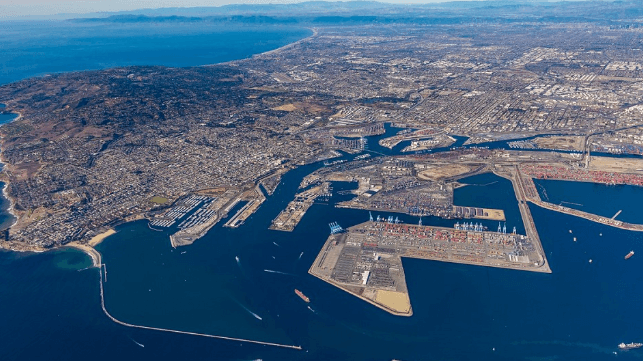Los Angeles Expects Record 2021 Volumes Despite Strong November Drop

The Port of Los Angeles remains on track for all-time record volumes in 2021 despite like its sister port in the San Pedro Bay experiencing a significant decline in both imports and export volumes during November. Briefing the media on the year and updating on operational issues at the busiest port in the United States, port officials said while progress is being made, there is still a long way to go to correct the issues that have made headlines in recent months.
“No one is declaring victory yet,” said Gene Seroka, executive director of the Port of Los Angeles. While pointing to strong declines in dwell time and the number of containers clogging the port, he also highlighted that 71,000 empty TEUs remain on the docks, with nearly two-thirds sitting nine or more days. He said the port urgently needs the carriers to bring more and larger sweeper vessels to move the empties away from the terminals and newly established intermediary holding points set up to deal with the surge of empties in the port.
While the Port of Los Angeles does not have final figures for November, they are expecting that the only part of the volume that increased was empties. The TEU volume of empties was up roughly 11 percent in November and in total, they expect empties will be up 43 percent for the full year. The shipping lines helped with one-way charters to clear empties from the port.
Seroka cited strong increases in the number of smaller vessels coming to the port as a key contributor to a volume decline that is projected overall at nine percent for November. Of the total of 86 vessels serviced at the Port of Los Angeles in November, half Seroka said had a capacity under 5,300 TEU. That compares with about a third of the ships under that level in October. Further adding to the port’s challenges in November were 24 extra loaders making ad hoc calls beyond the normally scheduled service by the carriers.
While saying that the overall supply chain remained strong and inventories in warehouses and retailers’ shelves were near normal, the Port of Los Angeles expects that November’s import volume declined more than 13 percent. The port projects just over 403,000 loaded TEU imports for November 2021 versus nearly 465,000 a year ago.
Export declines continued for 33 of the last 37 months dropping an “unprecedented 37 percent” according to the report. Seroka cited China’s retaliatory tariffs to the prior administration’s trade war and the strong U.S. dollar, as well as saying the “shoveling of empties back to Asia,” is contributing to the export issues at the Port of Los Angeles.
Combined, the ports of Los Angeles and Long Beach experienced their lowest volumes in November in nearly 18 months. The combined level of 765,000 loaded import TEUs is similar to the levels in June 2020 and reflects capacity declines on the routes from Asia. Sea-Intelligence in new research reports that the port congestion is creating a new phenomenon where careers are blanking sailings primarily between Asia and California because vessels are not returning on schedule due to long waits at the ports.
Despite the declines in volume, the Port of Los Angeles points to improvements on many of its metrics. The number of containers on dock has declined in total by 39 percent since late October with long dwell time boxes, nine days or more, down by 56 percent. The port believes the threat of surcharges for the carriers helped to reduce these numbers. Rail dwell time has also significantly improved from 13.5 days to approximately two days while truck dwell time is down by nearly half from 11 to six days.
In addition to the backlog of empties, Seroka cited other stress points in the system. Street dwell time for trucks he said remains too high and they need to get it back to pre-surge levels. He also acknowledged that approximately 100 containerships are either waiting in the anchorages or slow steaming toward San Pedro Bay meaning that the backlog of vessels remains at record levels.
Based on the strength year to date, the Port of Los Angeles is forecasting total volumes between 10.7 and 10.8 million TEUs. Those volume levels are about 13 percent ahead of the port’s highest ever volumes reported in 2018.
